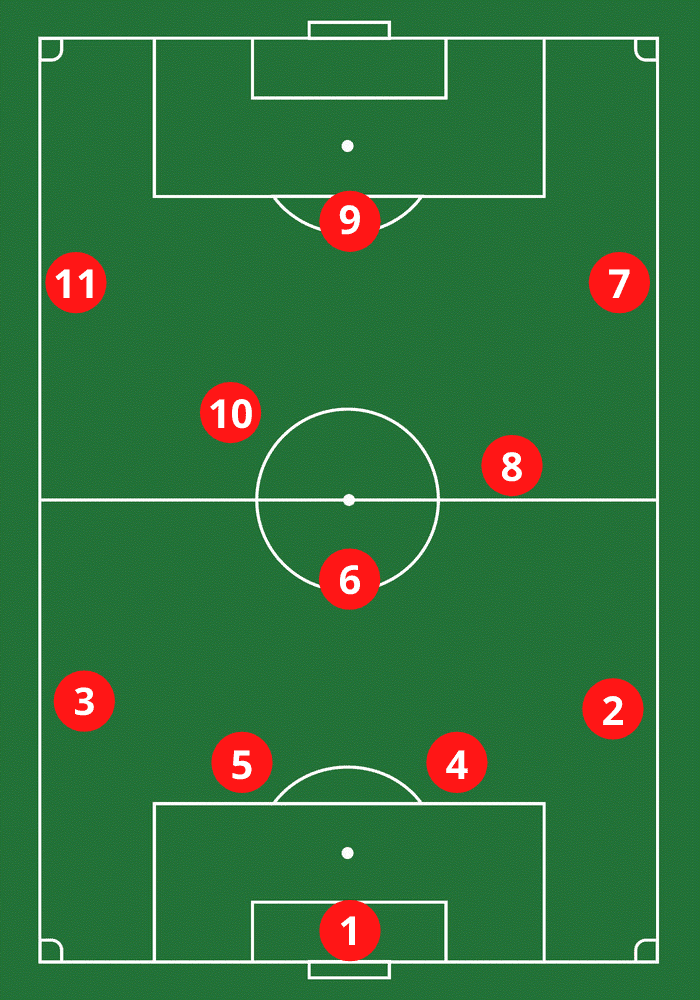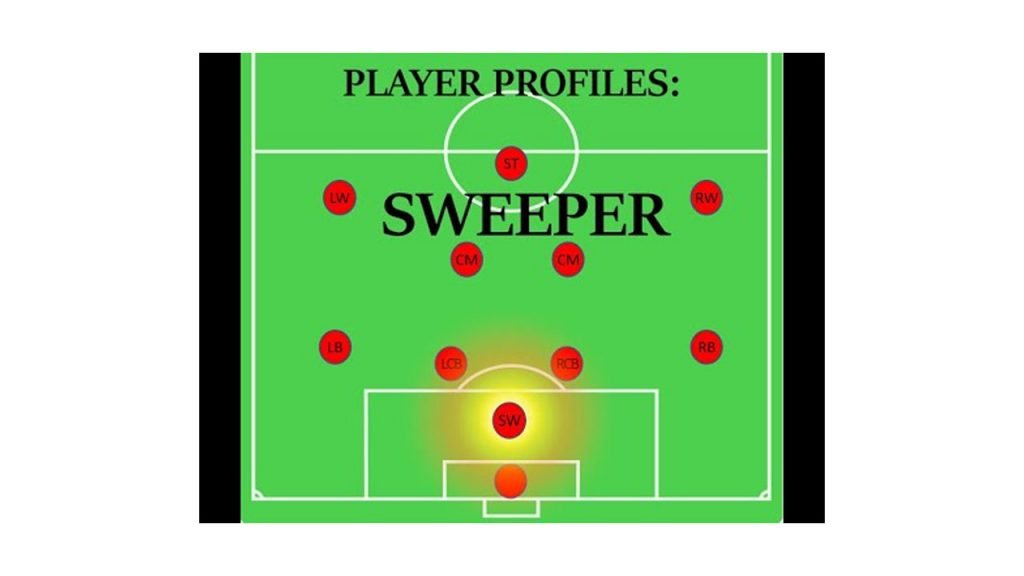The Sweeper Soccer Position : A Versatile and Dynamic Role
- Last Updated -
What Is The Soccer Sweeper Position?
The soccer sweeper position is a defensive position in the game of soccer. The role of the sweeper is to protect the goal and prevent the opposition from scoring. The sweeper plays behind the defensive line and acts as the last line of defense. They are responsible for clearing the ball away from danger and covering for any mistakes made by other defenders.
The sweeper position was popularized in the 1960s and 70s by the great Italian defender Franco Baresi. The sweeper is typically a player with excellent defensive skills, good vision, and strong leadership qualities. They must be able to read the game well and anticipate the opposition’s movements.
The sweeper position has become less common in modern soccer, as many teams now prefer to play with a flat-back four or three center-backs. However, some teams still use a sweeper, particularly in lower leagues or in countries where defensive football is still prevalent.
Overall, the soccer sweeper position plays a crucial role in a team’s defensive strategy. A good sweeper can make all the difference in a game, providing a strong and reliable last line of defense that can help to win matches and championships.
What's The History of The Soccer Sweeper Position?
The sweeper position in soccer, also known as the libero, has its roots in the Italian style of play in the 1960s. This position was introduced as a way to strengthen the defensive line and to provide a player with greater freedom to move forward and initiate attacks. The sweeper would sit behind the defenders, providing cover and support, and was also responsible for distributing the ball from the backline.
The first sweeper to gain widespread recognition was Franz Beckenbauer, who played for the German national team in the 1970s. He was known for his ability to read the game and his skill in initiating attacks from deep positions. Beckenbauer’s success helped popularize the sweeper position and led to its widespread adoption by other teams.
In the 1980s, the popularity of the sweeper position declined as teams began to favor more traditional defensive formations. However, the position experienced a resurgence in the 1990s, particularly in South American and European teams, and has remained a key component of many defensive strategies ever since.
The position of a sweeper in soccer or football can vary depending on the formation used by the team. However, traditionally, the sweeper is positioned just behind the defensive line and in front of the goalkeeper and is usually the #5 (left center back). In modern football, this position is often referred to as the central defender or the center-back.
The sweeper’s primary role is to prevent the opposing team from scoring by intercepting balls, clearing them out of danger, and closing down the opponent’s attacking players. This position requires excellent communication skills and a deep understanding of the game’s tactics, as the sweeper often acts as a leader on the field, coordinating the defense and directing the team’s play.
In some formations, such as the classic 3-5-2 or the 5-3-2, the sweeper is the sole central defender and has the responsibility of covering a large area of the field. In other formations, such as the 4-4-2, there are two central defenders, with one of them often taking on the sweeper role.

Where Did The Sweeper Role Come From?
The sweeper role in soccer, also known as the libero or the “sweeper-keeper,” originated in Italy in the 1960s. It was popularized by the famous Italian defender, Franco Baresi, who played for AC Milan and the Italian national team.
The sweeper position was created as a response to the attacking strategies of teams in the 1960s. With the introduction of the offside rule, attackers would try to run past the defensive line and score goals. The sweeper was placed behind the defensive line and had the freedom to roam around the field, intercepting passes and tackling attackers before they could get close to the goal.
The sweeper role became popular in the 1970s and 1980s, particularly in Italian soccer, where it was seen as a defensive innovation that could provide an extra layer of protection for the goalkeeper. Teams like AC Milan and Juventus employed legendary sweepers like Baresi and Gaetano Scirea, who helped their teams win numerous titles.
The sweeper position has evolved over the years, with some teams using it as a central defender in a back three formation, while others use a goalkeeper who is comfortable with the ball at their feet to play the role of the sweeper-keeper. Despite the evolution of the game, the sweeper position remains an important defensive role in soccer, and its origins can be traced back to the defensive strategies employed by Italian teams in the 1960s.
Is A Stopper The Same As A Sweeper In Soccer?
A stopper and a sweeper are both positions in soccer, but they are not the same thing. A stopper, also known as a center-back, is a defensive player who usually plays in front of the goalkeeper and alongside another center-back. Their main responsibility is to prevent the opposing team from scoring by blocking shots, intercepting passes, and tackling the opposing team’s forwards. They also help initiate attacks by passing the ball to their midfielders or forwards.
On the other hand, a sweeper, also known as a libero, is a defensive player who plays behind the center-backs. Their role is to sweep up any loose balls that the center-backs miss and to act as a last line of defense in case an opposing forward gets past the center-backs. They are also responsible for starting counter-attacks by passing the ball to their midfielders or forwards [1].
While both positions have defensive responsibilities, their roles are different. The stopper is more involved in the game and is responsible for marking specific players and helping to build attacks, while the sweeper is more of a safety net and is responsible for preventing the opposing team from scoring if they get past the center-backs. Therefore, a stopper and a sweeper are not the same thing, although they do work together to form a solid defensive line [4].
In conclusion, a stopper and a sweeper are both important defensive positions in soccer, but they have different roles and responsibilities. A stopper plays in front of the center-backs and is responsible for preventing the opposing team from scoring and initiating attacks, while a sweeper plays behind the center-backs and is responsible for sweeping up any loose balls and acting as a last line of defense.

What Are The Top Qualities of A Soccer Sweeper?
A soccer sweeper is a crucial player on a soccer team, responsible for defending the goal and preventing the opposing team from scoring. There are several qualities that make a great soccer sweeper.
Firstly, a soccer sweeper must have excellent communication skills. They need to be able to effectively communicate with their teammates, especially the goalkeeper and other defenders, to coordinate their movements and defend the goal as a unit. They also need to be able to communicate with their coach, receiving and implementing strategic advice during the game.
Secondly, a great soccer sweeper must possess strong leadership qualities. They must be able to inspire and motivate their teammates, take charge when necessary, and lead by example. They need to be able to read the game and make quick decisions, directing their teammates and adjusting their own movements as needed.
Thirdly, a soccer sweeper must have exceptional physical fitness. They need to be able to cover a lot of ground, run fast, and change direction quickly. They must also have good endurance to maintain their level of performance throughout the game.
Fourthly, a great soccer sweeper must possess excellent technical skills. They need to have good ball control, be able to pass accurately and be comfortable dribbling in tight spaces. They should also be able to shoot accurately and effectively when given the opportunity.
Lastly, a soccer sweeper must have strong mental toughness. They must be able to remain calm under pressure and not be afraid to make tough decisions. They need to be able to handle criticism constructively and be willing to learn from their mistakes.
In summary, a great soccer sweeper must possess excellent communication skills, strong leadership qualities, exceptional physical fitness, excellent technical skills, and strong mental toughness. These qualities are essential for success in this critical defensive role.
What Are Some Top Things To Remember When Playing The Sweeper Soccer Position?
When playing the sweeper position in soccer, there are a few key things to keep in mind to ensure success on the field. First and foremost, communication is crucial. As the last line of defense, the sweeper must be vocal and organize the defensive line, calling out the position of opposing players and directing teammates where to go.
Another important aspect of playing sweeper is positioning. The sweeper should always be in a position to cover for their fellow defenders, stepping up to challenge attackers when necessary and covering for defenders who may be out of position.
In addition, the sweeper should have good anticipation and be able to read the game, positioning themselves to intercept passes and make timely tackles.
Physicality is also important for a sweeper. They must be strong in the air, winning headers and clearing balls out of danger. They should also be able to make strong tackles and be comfortable with physical play, as they will often be called upon to stop opposing attackers in their tracks.
Finally, a good sweeper must have composure under pressure. When the ball is in their area, they must remain calm and make good decisions. This includes knowing when to clear the ball out of danger and when to play it safe and pass back to their goalkeeper. A composed sweeper can make all the difference in a close game.
In summary, to play the sweeper position successfully, a player must have good communication skills, positioning, physicality, and composure under pressure. By keeping these key things in mind, a sweeper can make a big impact on the field and help their team to victory.
What Are Some Things to Avoid While Playing The Soccer Sweeper Position?
When playing the soccer sweeper position, there are several things to avoid to perform effectively. Firstly, it is important to avoid being too aggressive and committing unnecessary fouls, as this can result in free kicks or even yellow or red cards. Sweeper is responsible for clearing the ball from the back, but they should also avoid making blind clearances and kicking the ball aimlessly. Instead, they should look for teammates to pass the ball to or take their time to make a more accurate clearance [6].
Another thing to avoid while playing sweeper is getting too far forward and leaving too much space behind, which can create opportunities for the opposing team to counterattack. Therefore, it is important to maintain a good balance between defensive and offensive play.
In addition, sweepers should avoid being complacent and assuming that their team’s defense is impenetrable. It is important to remain alert and aware of potential threats at all times.
Lastly, a sweeper needs to avoid being isolated from the rest of the defense. The sweeper position requires excellent communication skills, and they need to constantly communicate with the goalkeeper and defenders to ensure that they are all on the same page. Isolation can lead to confusion and miscommunication, which can result in costly mistakes.
In conclusion, avoiding unnecessary fouls, blind clearances, complacency, isolation, and maintaining a balance between offensive and defensive play are some key things to keep in mind while playing the soccer sweeper position.

Do Modern Professional Teams Ever Play With A Sweeper?
A sweeper is a type of defensive player who is positioned behind the rest of the defenders to provide additional support and coverage to the team’s defense. While the use of sweepers has decreased in modern football, some teams still employ this strategy. In terms of current professional teams, it is difficult to provide a definitive answer without more specific information about which league or region is being referred to.
However, it is worth noting that the use of sweepers has become less common in modern football due to tactical developments and changes in the rules of the game. As teams have increasingly moved towards a more aggressive and proactive defensive strategy, the need for a sweeper has diminished. Additionally, changes to the offside rule and the increased use of pressing have made it more difficult for sweepers to play an effective role in modern football.
That being said, some professional teams may still use sweepers in certain situations or for specific matches. For example, teams that are focused on defensive solidity or have a particularly physical style of play may choose to employ a sweeper.
Teams in lower-level or regional leagues may be more likely to use this strategy as they may not have access to as many talented defenders or resources for developing more complex defensive tactics.
Overall, while the use of sweepers has become less common in modern football, there may still be some professional teams that utilize this strategy to varying degrees depending on their tactical approach, resources, and level of competition.
Does A Soccer Sweeper Ever Get To Attack?
A soccer sweeper, also known as a “center back,” is typically known for their defensive skills and ability to prevent the opposing team from scoring goals. While sweepers are primarily responsible for defending their team’s goal, they may also have opportunities to attack during the game.
In certain situations, a sweeper may move up the field and join the team’s offensive attack. This is typically seen in situations where the team is trailing and needs to score a goal. The sweeper’s role in the attack is usually to provide support to the forwards and midfielders by making overlapping runs, providing long passes, or even taking shots at goal if the opportunity presents itself.
However, a sweeper’s attacking responsibilities are limited compared to other players on the field. Their primary role remains defensive, and they must be cautious not to leave their position and expose their team’s defense to counterattacks. Great sweepers possess high IQ and strong communication skills that allow them to sense danger and communicate effectively with their teammates to prevent defensive breakdowns [1].
In conclusion, while a soccer sweeper’s primary role is defensive, they may have opportunities to attack in certain situations. However, their attacking responsibilities are limited, and they must remain cautious not to leave their defensive position vulnerable to counterattacks.
Who Are The Best Sweepers to Ever Play Soccer?
The best sweepers are able to move the ball effectively and are known for their ability to attack the ball before it reaches other players or the goal line. Here are some of the best sweepers to ever play soccer, according to the provided web search results:
- Franz Beckenbauer: Known as “Der Kaiser,” Beckenbauer is considered one of the greatest soccer players of all time and a pioneer of the sweeper position. He won the World Cup as a player and coach and was known for his elegance on the field.

- Franco Baresi: Baresi is considered one of the greatest defenders of all time and is known for his ability to read the game and make crucial interceptions. He spent his entire career with AC Milan and won numerous titles with the club, including three European Cups.
- Bobby Moore: Moore captained the England team that won the 1966 World Cup and is widely considered one of the greatest defenders in the history of English soccer. He played most of his career at West Ham United and was known for his composure on the ball and leadership qualities.
- Gaetano Scirea: Scirea was a key player for the Juventus team that dominated Italian soccer in the 1970s and ’80s [2]. He was known for his intelligence on the field and ability to read the game [4].

- Velibor Vasović: Vasović played for Ajax and was a key player in the team that won three consecutive European Cups in the early 1970s. He was known for his technical ability and versatility, as he could also play in midfield.
- Matthias Sammer: Sammer played for Borussia Dortmund and won the Ballon d’Or in 1996. He was known for his ability to play as both a defender and a midfielder and his technical ability on the ball.
- Daniel Passarella: Passarella played for Argentina and is considered one of the greatest defenders in the history of South American soccer. He captained the Argentina team that won the World Cup in 1978 and was known for his leadership qualities.
What Is A “Sweeper Keeper” in Soccer?
In soccer, a sweeper-keeper is a goalkeeper who plays a more active role in the game than most traditional goalkeepers. A sweeper-keeper is aggressive and proactive when it comes to defending their goalposts and acts as an eleventh outfield player by becoming an extra defender at points in a game [3].
They push themselves up the pitch and stay close to the last line of defense, controlling the space behind their defense. A sweeper-keeper is not afraid to come off their line and sweep up any loose balls. They have a unique playing style that involves playing a more active role in the game than most traditional goalkeepers, and they are known for their ability to attack the ball before it reaches other players or the goal line.
The job of a sweeper-keeper stretches further than just keeping the ball out of the net. They regularly push high up the pitch in order to control the space behind their defense, acting as an extra defender and enabling their team to play a high defensive line. They are also responsible for making quick counter-attacking throws with hastened speed and efficiency.
The role of a sweeper-keeper has evolved to account for the modern soccer play style. The position has historical roots, and it has evolved throughout history to become what it is today. It is a specialized position that requires the player to primarily have defensive responsibilities [6].
In conclusion, a sweeper-keeper is a goalkeeper who plays a more active role in the game than most traditional goalkeepers, acting as an eleventh outfield player and an extra defender at points in a game. They push themselves up the pitch and stay close to the last line of defense, controlling the space behind their defense, and are not afraid to come off their line and sweep up any loose balls.
They have a unique playing style that involves playing a more active role in the game than most traditional goalkeepers.
The Evolution of The Sweeper Soccer Position.
The sweeper position in soccer has a rich history that can be traced back to the 1930s. Karl Rappan, who was coaching Servette in Switzerland during that time, is believed to have invented the sweeper position, which he called “catenaccio,” meaning “chain”.
This defensive position was designed to provide an extra layer of defensive protection behind the team’s defensive line. The sweeper, who is the last line of defense, moves in unison behind the rest of the defensive line, providing guidance and protection like a shepherd guiding their flock.
The sweeper position can be used in any formation, but historically, it was most commonly seen in the 3-5-2 and 4-4-2 formations. The 3-5-2 formation allowed for a spare player in the three-man backline, which was usually filled by the sweeper. The sweeper was and still is used by teams who need additional help defensively, especially against better opponents.
During the 1960s and 70s, the sweeper revolutionized the game of soccer and led the way for more “hybrid positions” to make their way into the game. Playing just behind the center backs, the sweeper had somewhat of a free role in the sense that they didn’t mark a specific player.
However, with time, the sweeper role has evolved to account for the modern soccer play style. In addition to being the last defensive player, a sweeper also serves as a playmaker for the team, and in some languages, sweepers are referred to as libero, which can be translated to the leader.
In the modern game, the sweeper position has become almost eliminated, and it is challenging to find a dominating soccer sweeper. Modern professional soccer is generally played with a flat back four, and the sweeper position has been almost eliminated [10]. However, a variation of the sweeper position, the sweeper-keeper, has emerged.
The sweeper-keeper’s primary function is to keep the ball out of the net, like any other goalkeeper, but they also serve as an extra defender, often sweeping up any loose balls behind the defensive line.
Sweeper-keepers are now one of the staple soccer positions in the modern game, with notable players such as Ederson, Manuel Neuer, Alisson Becker, and Hugo Lloris.
Summary of Sweepers in Soccer
In soccer, a sweeper is a defensive position typically positioned behind the rest of the backline. The sweeper’s primary responsibility is to offer an extra layer of defense by being the last line of defense before the goalkeeper. They are responsible for cleaning up any loose balls that may get past the other defenders and preventing opposition attackers from penetrating the defense.
In addition to defensive duties, sweepers must also have strong on-the-ball skills and possess playmaking abilities to break through the opposition lines and assist in their team’s attack.
They are often viewed as safety nets, frustrating attackers and providing an additional barrier for the opposition to break down. In the past, sweepers were used effectively for many decades from the 1940s through the 1980s, but their play style is no longer viable in the modern game, as the game has moved up the field.
Sweepers were traditionally known as “liberos” in some languages and were positioned to guard the defensive line. They do not necessarily man-mark but instead “sweep in” when things get ugly on defense, which is why they are called “sweepers” [9]. Although the position has evolved throughout history, it still sees mixed use in today’s game.
To summarize, in soccer, a sweeper is a defensive player positioned behind the rest of the backline, responsible for offering an additional layer of defense by cleaning up any loose balls that may get past the other defenders and frustrating opposition attackers from penetrating the defense.
They must also have strong on-the-ball skills and possess playmaking abilities to assist in their team’s attack. Although the position has evolved throughout history, it still sees mixed use in today’s game.
Soccer Substitution Rules: The Strategic Art of Changing the Game
Soccer, known as the beautiful game worldwide, has seen various changes to...
Read MoreThe Historical Dominance of Brazilian Soccer in the World Cup
Introduction: The Beautiful Game's Grandest Stage The World Cup, a grand tournament...
Read More



















